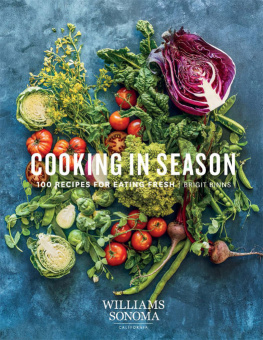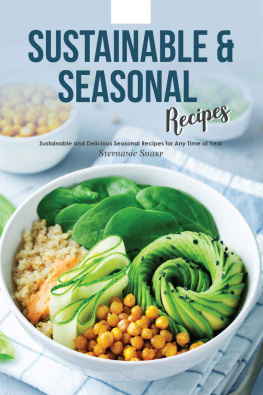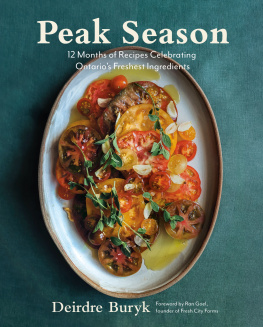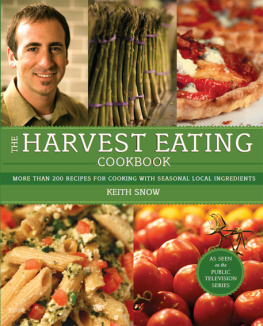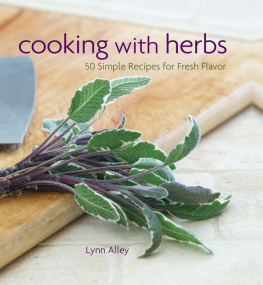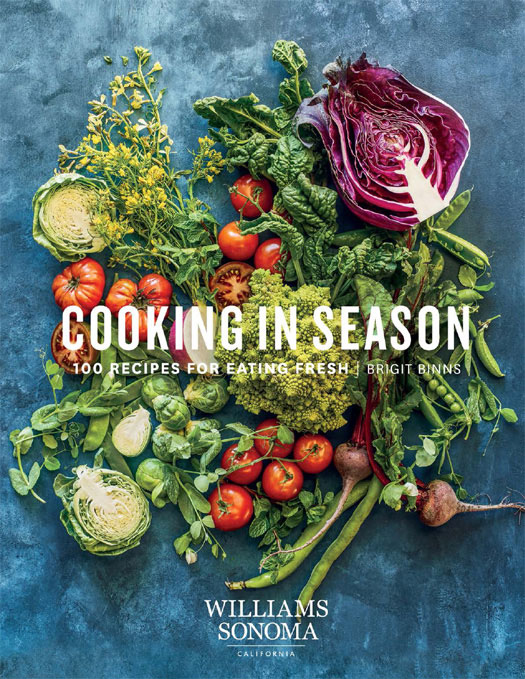
COOKING IN SEASON
BRIGIT BINNS
PHOTOGRAPHY BY
RAY KACHATORIAN


INTRODUCTION
As a second-generation Californian, I learned from an early age to celebrate the seasons. When I was a kid, the arrival of spring excited me not (like my schoolmates) because it was almost swimming season, but because artichokes would soon be on my familys tableideally, at least twice a week.
Back then (at least in urban Los Angeles), there were no wild mushrooms, no Romanesco broccoli, no multicolored beets. But we ate well and always in tune with the seasons because my mothera great, if limited, cookspent much of her youth on a cattle ranch near Santa Barbara. There, they grew their own vegetables and relied on twice-monthly forays to civilization for staples.
Annual summer visits to Connecticut allowed me to learn at the foot of a passionate vegetable gardener, the legendary mystery novelist and gourmand Rex Stout. Have the water boiling before you pick the corn, he insisted, then run from the plant to the pot. Rexs rustic grilled beef was legendary, and I still try to re-create it every summer.
Later, ten years in Europe exposed me to many fruits and vegetables than hadnt been available during my American upbringing. Six and a half years in England gave me a whole new appreciation for brussels sprouts and parsnips, but left me literally starved for bright, sunny food. The following three and a half years in Spain opened my eyes to the bounties of a warm-climate diet.
Then, somewhere along the way, I ended up in a rut. It was almost like the farmers markets were for special occasions only; I stopped experimenting. Working on this book pushed me outside my comfort zone, and I fell in love with ingredients Id only admired from afarDelicata squash, watermelon radishes, Romanescoand rekindled love affairs with forgotten foods: sweet potatoes, pomegranates, kiwifruit. It motivated me to think outside the box and invigorated my approach to dining both at home and in my cooking classes on Californias Central Coast.
With this collection of recipes tailored to the seasons, you too will discover new flavors and inspiration, then create colorful (and healthy) meals using impeccably fresh produce for yourself and your family.

BUY LOCAL
Today, its easier than ever to shop and eat locally and seasonally. But theres no need to insist that every single thing on your plate was grown within one hundred miles. As long as you make your best effort, youll feel good on so many levels. The planet, your taste buds, and your health will all benefit.
CHECK RIPENESS
With some notable exceptions, most vegetables and fruits in the market should be ripe. Yet each has its own secret handshake, and they are all worth learning. For example, when selecting pears, gently press near the top of the fruit around the stem; if it has any give at all, the pear is ripe. (By the time the side of the fruit feels soft, its overripe inside.) Avocados are unusable until there is some give in their dark, knobby skin. Smaller fava bean pods yield little lime-green gems, barely in need of cooking, while beans from larger pods are best for braising.
STORE SMART
After you bring home the seasons bounty, treat it with respect; your refrigerator is not the place for all produce. Tomatoes should never be refrigeratedits a recipe for flavor loss. Leafy greens like chard, kale, and spinach must be kept chilled or they will wilt. Different members of the onion family go opposite ways: store leeks and green onions in the fridge, and red, yellow, and white onions on the counter or in a cool, dry pantry or cellar. (Rinse produce only when ready to use, never before storing in the refrigerator.)
COOK SEASONALLY
Many seasonal cooking techniques are no-brainers, especially if you live in a place where winter weather closes down the grill. Thats when braising and roasting come to the rescue (think Cider-Braised Chicken and Pizza with Roasted Broccolini) and soups like Butternut Squash with Coconut Milk and Wild Mushroom Soup become lifesavers. In summer, much of the action is at the grill. Grilled Peach Flatbread with Burrata offers a rich marriage of flavors, but steaming or grilling vegetables and protein before the fierce heat arrives can also lead to even more summer-friendly repasts. Im calm, cool, and collected when serving salads and chilled or room-temperature composed dishes like Summer Vegetable Ceviche and Blistered Padrn Peppers with Charred Lemon and Spicy Garlic Aioli.


Market bins piled with bright green vegetablespeas, fava beans, asparagus, leeks, delicate lettucessignal the arrival of spring. Cooking is quick and easy this time of year, with stir-fries, pan-seared seafood, and stove-top noodle dishes taking center stage.

A PALETTE OF RADISHES
If you cant find watermelon radishes, pick up a couple of bunches of crisp, mild, colorful Easter egg radishes, in a vivid mix of pink, crimson, deep purple, and white.
Watermelon Radish Salad with Herbed Cheese, Blood Orange & Chives
Watermelon radishes, which thrive in cool spring weather, are large and round, which makes a V-slicer or mandoline the best tool for shaving them paper-thin. Either tool also makes quick work of reducing the jicama into uniform matchsticks.
FOR THE VINAIGRETTE
1 blood orange
1 shallot, minced
2 tbsp fresh lemon juice
tsp cayenne pepper
tsp salt
tsp freshly ground black pepper
cup (60 ml) grapeseed oil
3 tbsp extra-virgin olive oil
2 blood oranges
small jicama, about lb (375 g), peeled and cut into -inch (3-mm) matchsticks
4 tbsp ( oz/15 g) finely snipped fresh chives
1 tbsp coarsely chopped fresh flat-leaf parsley
2 watermelon radishes, peeled and thinly shaved crosswise
9 oz (280 g) very cold goat cheese
serves 6
To make the vinaigrette, use a serrated knife to cut a thick slice off the top and bottom of the orange. Stand it upright and, following the contour of the fruit, carefully slice downward to remove the peel, pith, and membrane. Holding the fruit over a large, shallow bowl to catch the juices, cut on either side of each segment to free it from the membrane. Squeeze the membrane to release the juice into the bowl. Cut the segments crosswise into small pieces, discarding any seeds, and add to the bowl. Add the shallot, lemon juice, cayenne, salt, and black pepper. Whisking constantly, slowly add the grapeseed oil and olive oil and whisk until well combined.

